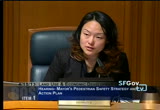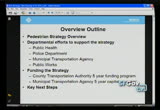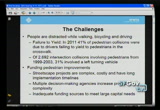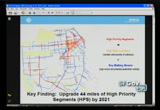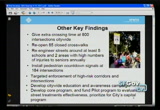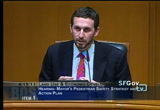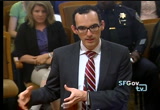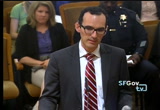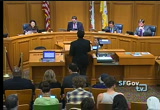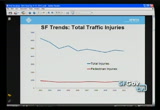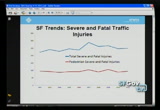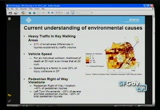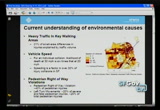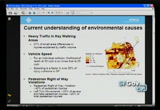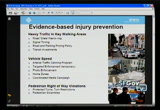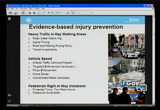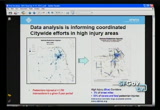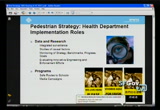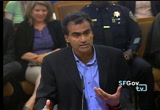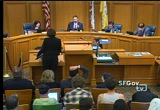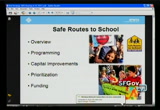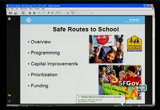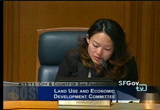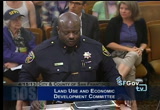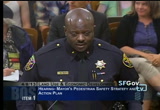tv [untitled] April 20, 2013 1:14am-1:44am PDT
1:14 am
together to have one vision and improve the physical environment and with that said supervisor kim i will turn it back to you. >> thank you chair and i do want to acknowledge we have a enlighten board of supervisors in terms of our understanding of pedestrian safety, and i think a lot of that also is due to a lot of activists and community members who made this a priority issue to educate government and members of the community on this issue and of course they have been impacted on this as well and hopefully through the hearings we can push and encourage for better working -- a better coordination amongst a variety of departments and this sits in a lot of different purviews so again i want to invite you up and chaired the task force and a member of the sf mta. thank you for being here. >> thank you supervisors. i am deputy of planning for the sf mta also the transportation
1:15 am
task force, co-chair with dhp. i'm going to give you a quick overview of the strategy and then what we're going to be talking about in the hearing so you can hear from the various departments on what they have have done since we have been developing this report. it's really important to note that we have been working over the last two years as a team and moving concert with the changes and the strategy is reflecting in real time what we're doing and moving forward and there is obviously a lot of challenges moving forward but i think together we will figure those out, so what you will hear today, the overview i will touch upon, and then the departmental efforts to support the goals and objectives and you will hear from public health, the police department, and mta and public works and we go into funding strategy. how are we going to fund this? we know there are certain gaps in
1:16 am
certain areas. what is the plan of attack to get there? and both the mta and capital group are going to present that and key next steps and we have to come back to you regularly to show the updates so just a quick record on the strategy itself. it was in response to the mayor's objective to reduce fatal injuries and increase walking trips as well. as a city we're growing. we will have more transit oriented development which means more pedestrian trips and look at making it safeer and workable and then we have to look at completing safety and action items for the rest of the strategy. this chart shows you the current trend over the
1:17 am
last 10 years the severe in the light pink and the fatal in the dark pink and the trend it was on a precipitous decline but now holding steady and on the increase so a lot of concern there and we will talk about that in more detail what is mapping so the key challenges ahead of us we have a great city, very walkable. a lot of people walk and since the inception of the smartphone and walking and driving and taking transit and these issues we're working on, but the key issue that people driving are failing to yield for pedestrians. that's the bottom line and we need to correct that and importantly as well of all the collisions involved with pedestrians in the last few years and this is the area that we looked at a lot involved cars turning left so projecting the
1:18 am
left turn, making it more visible is one of the key obstacles going forward. we know that we can do more of these core issues and like supervisor wiener was speaking of changing the street scape and they're becoming more complex and means more focused areas and we need to look at this from a city perspective and the multiple agencies how can we have it done quickly but robustly and a challenge in our
1:19 am
street network so it's a targeted area to focus resources on. through the process it helped determine what we are doing as city agencies and how to implement this so the key finding that the report talks about is looking at our intersection city wide, giving more crossing time and reopen what we call closed crosswalks and we only have one or two legs open and open all four to make it safer, look at streets around schools, finishing our signal count down program, having target enforcement at certain corridors, develop the education and awareness program, and really looking at developing
1:20 am
and funding the core program and developing something which is looking at pilots, a lot more pilots to see the efficacy of the treatments and we haven't applied these in san francisco yet so we want to test them out for efficacy and as they prove themselves we can make them as part of the capital program and do more likely so you will hear about that. also we're not going to sop stop with this support. we will have a task force development criteria for the next steps and then every year provide an annual evaluation report on what did we do? how well did it achieve the goals and how close are we to the achievements? and then develop the five year prioritization of projects so we keep feeding them into the city's capital plan so
1:21 am
that is a high level overview. i will now have the departments come individually and let you know specifically what is happening and how we can move forward. next up is dr. batia from the department of public health. >> i have a question. so when we have a pedestrian safety projects moving forward or formulated who is in charge? >> who is in charge of the actual -- >> who is -- which department or which position? who is actually responsible for making sure it goes forward? because i think one of the challenges that we had is that you have so many agencies involved that have legit mast goals and interest that we sometimes don't have the level of centralization that we need and one thing i have seen we like to operate by consensus and it's the best option if you can do it but there are times
1:22 am
when you have disagreements and you have to make a decision and move forward so who ultimately is in charge? >> supervisor that is a good point. that's an on going theme of the task foshs and as we looked towards the mta and the ultimate decision with the projects and working with them and that's basically where we have to make the decision to move these projects forward. it really needs to be there. >> so if another department has an objection. >> we work with them and figure out the key issues. we have advisory committee to talk about the issues. if it gets to a point there is a disagreement
1:23 am
and philosophical or whatever it is have to meet one or one and figure it out and with what we know if it's pedestrian safety issue we need to move forward on it. >> can you think of other examples and you had philosophical disagreement s and the mta said we respect your position but this is important and we need to move forward with the project. >>i think most are resolved at that level. mostly it's when thinking about the project and the scope of work. sometimes there are issues with the width of the street and turning and that type of thing, the number -- it's very specific to the projects but we generally get to a point nonetheless we need to move forward and accommodate the needs and rarely do we have opposition from the city departments. on an on going theme as we do more of these
1:24 am
transit type projects we need to come forward and think that through. >> just another observation i have sometimes i feel the projects when you have opposition or concern from other departments it ends up the project gets severely watered down. that is my experience and i would love to see the mta be more proactive saying we need to deliver this and of course taking into account the feedback from the other departments but when there are some of the good faith disagreements not just watering down the project. >> yeah, i think now that we have this we can point it and we can make the case again and again. >> great thank you. >> thank you. >> good afternoon supervisors. i am [inaudible]. i'm the medical director of environmental health. i co-chair the task force with tim. the health department's
1:25 am
role just to give you after overview i think what we do well is provide good data and evidence, and i think data and evidence on where the injuries are happening, to whom, data and evidence of what are the avoidable causes? i think there is science on that and myths on the a joidable causes and i think we can uncover those and what are evidence based solutions? we do programs for education and cultural awareness and we will talk about those in the context of the plans. i am sharing the analysis that you requested. i will say a little bit more about that. i think starting -- do both mics work? starting with the trends this first slide, and i will go through these quickly. i think we can see the total injuries -- i think it's important for you -- for everyone to look at these at data for pedestrian injuries and all traffic injuries in
1:26 am
terms of trends. it's misleading to look at a short period of time. it's misleading to look at just one intersection because these are relatively rare events but with the thousands of intersections they collectively add up but just to follow one intersection or one statistic from day to day or month to month is really misleading and lead us down the wrong road but over a decade injuries overall have defined but for pedestrians remained stable which is not acceptable. when we look at severe and fatal injuries we see an uptick in the number happening in the city and i think this is in part because of increase in bicycle injuries over the past few years. now, the last data point you will see here is from 2011 and i will explain why a bit later when i talk about the need for
1:27 am
integrated pedestrian surveillance. we get the data. the data is collected by the police department. it goes to the state. the state clean its up and we get it back as an electronic record. we are trying to shorten that loop and get it from the police department so we can do the work with the data but that's why the last data point that you see here is 2011. we have data from coroner's reports directly. there were seven fatalities. 12 traffic fatalitys in the first quarter in san francisco and seven for pedestrians. the other important point is almost half of the fatalities and serious injuries occur pedestrians. these are the most vulnerable group to injury and death on san francisco streets. i'm not going to go through every point in the slide but a few. a current understanding of what are the environmental
1:28 am
causes of injuries and i think our traditional focus, and i think this is one of the ways we're changing we are looking at it as an environment problem, environmental right to save streets, as an environmental protection issue. not just simply who is to blame? who did something wrong? it's important to take a balanced approach to that, so one of the important causes is kind of intuitive but we don't focus on. it's the traffic itself. one fifth of the variation from neighborhood to neighborhood is the differences in traffic. the second important cause is vehicle speed. vehicle speed is really responsible for all of the serious fatal and serious injuries. it's a contributing cause. if the vehicle didn't hit you very fast you're not likely to die and we know we will have pedestrians and
1:29 am
vehicles bump into each other. maybe we can't avoid that but we can avoid the death focus we slow the speed down. while we assess speeding and we know that 20% of the injury collisions are attributable to speeding we don't know what the impact of speed itself is because people are traveling 5/10 miles over the limit and not considered speeding yet that limit is having important and direct impact on serious injuries and fatalities and the third point of the most important causes i think we ought to focus on is pedestrian right-of-way violation, and tim highlighted this. it's come down from the 30% from the data 10 years ago, but 25% of the total pedestrian injuries are in from left turns and let me draw you a picture. this is a pedestrian at an
1:30 am
intersection. he or she is crossing in a crosswalk. they have the right-of-way. the signalized -- the pedestrian signal is saying walk. that guy is flashing and there is time and they're hit and i think if you think about it -- i think if you think about it you can see drivers probably -- some drivers maybe distracted but drivers are naturally trying to protect themselves from the car from the other direction. they maybe less teantdive to the pedestrian and we need to think and do something about that, so following up what can we do about it? and i think i am very proud of the pedestrian strategy because many of the known evidence based solutions are in this strategy and we do need to deliver on them, but i think we can get to our injury reduction goals of 50% if we do deliver
1:31 am
on the items in this pedestrian strategy. i am very confident on that based on how other cities perform who do this, so a few things that are going to need the support of the board of supervisors are policies like photo enforcement. photo enforcement is the proven effective way of reducing speeding. we can do targeted enforcement for speeding. we can employ police to do, but usually that targeted enforcement is temporary in its nature. the other thing i think to really focus on is the protections for the pedestrians from turning vehicles and things like scrambles, protected left and right turns are known proven strategies to do this. now, the department's not going to suggest any particular solution. all of these things
1:32 am
i think need to balanced and engineered proatly. we have accomplished quite a bit and one thing that was impactful was this pedestrian high injury corridor map and this map basically changed the way of looking at pedestrian injuries from okay it's everywhere to the areas where we have it. we developed an enforcement plan about a year ago where the police department was going to deploy their man and women power to the high injury corridors and we are interested in looking at the results from that which get me to the last slide which has to
1:33 am
do with roles going forward. i think we -- what we intend to do and what we really need to do is have an integrated surveillance system. even with all of the numbers 20% of the injuries are not counted and we're getting this data late, so we need to as the data keeper for the city we need to bring the data from the ambulance and the hospital and the police department and the coroner's records and be able to give real time results,. one, because that's what the public wants and if we're going to find out the causes we need a full picture. if we're going to monitor and evaluate the policies we need that data. if we're going to evaluate the whole plan we need the data. i'm going to have anna speak about our school programs and media campaigns but i will leave you on a personal note with a
1:34 am
few key challenges. one is we need to get away from blaming the pedestrian and the driver. we need to anticipate as cities that design streets what the behaviors are and try to project people who maybe drinking, who maybe distracted, who maybe making mistakes. those mistakes shouldn't be lethal in my opinion. we are a walking city but also a driving city. we are two cities and we have to figure out how to balance that. i think in some of the other cities with lower pedestrian injury rates but high walking cities they're walking cities and not driving if you look at london or a city like that. they're walking and transit city and we are still many things and we're still trying to figure that out and i think that is very important thing to do, but please hold us accountable to this strategy. it's a good strategy and there's a lot of work to do. >> supervisor kim.
1:35 am
>>i just wanted to ask about the warehousing or the sharing of data which i think is important in planning for the improvements because we want to maximize the out comes in terms of pedestrian safety and of course we have limited resources so we got to put the dollars where it's most effective so you talked how we can cut the state -- not cut the state but get the information from them to dph and it's possible and how can we get there and how can we support that and get the quarterly reports from sfpd to put that data in? >> on our end, the receiving end, we are developing the data sharing agreements with the departments including the hospital and the police department and the ambulance and the cor94 and we have designed a system to collect the data and
1:36 am
remove the duplications, the technical side of that. on the police department's end i think they're working on getting the technology to more quickly record the data, so i will let them speak. there is no roadblock in them giving the data to us. it's just they're having -- there are issues on their end so we're prepared. we're deploying new staff to this function and we spent about a year designing that function so we're excited about that. >> thank you. >> thank you. >> good afternoon supervisors. i am anna and i am going to talk about pedestrian safety as it relates to schools in our city. i manage the safe routes to school project and one of the key indicators in this strategy is increase walking trips to and from school so i wanted to give you a quick overview. we are
1:37 am
about promoting safe and active walking to and from school -- also bicycling to and from school for children and their families. we work with a number of city agencies, many are in the room. also community base partnerships and of course the school district. there are two elements to the safe routes to school program. there is the program side which we manage which we go in and do what we call the 5e's, education and encouragement, enforcement and engineering and evaluation. our program does three of those. we're working with all of the agencies for these and of course there is the capital improvements mainly our partner at mta how we can improve the environment around the schools so it's safe to ask the families to walk to and from school, and -- our school district has
1:38 am
about 120 plus schools so we need to obviously prioritize the schools. right now we're working in 15. we have one in every supervisory district but there is a great need out there, so for the program side what we do is we look at the -- we have a lot of data we compiled. particularly we look at schools who have a majority of families that live within a mile of the school so it's realistic to ask them to walk and bike to school and we also want to look at schools to increase the rates and mta looks at schools that have high rates of walking and high rates of injury and gene parker at the foot of the tunnel is ranked number one and competitively awarded great grants because of that data we have been able to compile which
1:39 am
leads into funding so we are 100% grant funded but we're working right now on a proposal to the transportation authority which we will hear about tomorrow in plans and programs to continue the program through summer of 2017 so we have about four years ahead of us where we can do amazing work and that is my quick snap shot. >> supervisor kim. >> through the chair i had a quick question and i know we will talk about this at the ta hearing and the joint hearing with the school district as well and i will ask questions there. have we identified if any of the schools are along the 44 miles of priority candidates? >> we haven't done that over lay but that is the obvious next step to take. >> you mentioned that we have data on schools where there are high numbers walking and i am curious -- >> we are bringing it tomorrow.
1:40 am
>> great. and where the collisions, the injuries exist. >> yeah. >> great. thank you. >> and we can also email that out. >> that would be very helpful. >> thank you. sfpd next. >> good afternoon supervisors. i am here to effectively address three areas and although there are three separate areas they're interconnected in their implementation. as the board obviously knows the police department has had staffing challenges over the years. as we look at this slide currently before you just in the last two years we have seen a reduction in staffing of some 300 officers. one of the hardest hit areas within the police department actually was the traffic company and that's in large part to the level of
1:41 am
seniority that actually took to become a member of the traffic company, to be a member of the motorcycle unit and so forth, so as we rebound with a robust hiring plan under the mayor's leadership here we are prioritizing full staffing levels for the traffic company and the motorcycle officers. in fact we have a class that is going through right now at treasure island but those three areas i want to focus in on the enforcement, investigation and technology. >> when do you think -- when do you anticipate the department is at full staffing in the traffic company? >> we're looking at a 18 month full staffing plan. the training for motorcycle officers is comprehensive. it's eight weeks in training and although they're members who desire to be a part of this there are some people that don't have the necessary skills, so you may start with a group of 10 officers in the training class
1:42 am
which is a manage annual group only to finish with six or seven just because of the rigor of the training itself which is predicated on the environment in which our officers separate in the city and the demand for the work that they need to do. >> and my understanding who pays -- does the mta pay for the traffic company? >> the mta pays about 70% cost of traffic company. >> and who -- does sfpd do reporting back to mta to make sure they're getting their money worth? i know you have staffing challenges but in terms of knowing exactly what is happening? >> sure we give a report to the mta and i can actually speak to that relative to technology as well, but on a monthly basis we report enforcement operation plans. we have a conduit by which we provide traffic
1:43 am
collision information. it's not the most effective and efficient way of doing it, but we have that in place currently. as i get further in the presentation i will point out there is technology we want to have basically in place and pilot in place by june that is effectively real time in terms of not only traffic collision information about also enforcement. >> thank you. >> all right. so as we talk about the issue of enforcement and prioritizing in december of last year the mta issued an analysis of all traffic collisions over the last 10 years and i think that was referenced earlier. in identifying the top collision factors involved in our collisions speeding red light, failure to yield to pedestrians, stop signs and fail to yield when taking a u turn are part
36 Views
IN COLLECTIONS
SFGTV: San Francisco Government Television Television Archive
Television Archive  Television Archive News Search Service
Television Archive News Search Service 
Uploaded by TV Archive on

 Live Music Archive
Live Music Archive Librivox Free Audio
Librivox Free Audio Metropolitan Museum
Metropolitan Museum Cleveland Museum of Art
Cleveland Museum of Art Internet Arcade
Internet Arcade Console Living Room
Console Living Room Books to Borrow
Books to Borrow Open Library
Open Library TV News
TV News Understanding 9/11
Understanding 9/11
